


 الفيزياء الكلاسيكية
الفيزياء الكلاسيكية
 الكهربائية والمغناطيسية
الكهربائية والمغناطيسية
 علم البصريات
علم البصريات
 الفيزياء الحديثة
الفيزياء الحديثة
 النظرية النسبية
النظرية النسبية
 الفيزياء النووية
الفيزياء النووية
 فيزياء الحالة الصلبة
فيزياء الحالة الصلبة
 الليزر
الليزر
 علم الفلك
علم الفلك
 المجموعة الشمسية
المجموعة الشمسية
 الطاقة البديلة
الطاقة البديلة
 الفيزياء والعلوم الأخرى
الفيزياء والعلوم الأخرى
 مواضيع عامة في الفيزياء
مواضيع عامة في الفيزياء|
Read More
Date: 11-8-2020
Date: 5-8-2020
Date: 25-2-2016
|
γ -ray astronomy: Cˇ erenkov radiation and detection
When high-energy γ -rays pass through a medium, their production (e+e− ) may take place with the resulting particles travelling faster than the local speed of light (c/μ, μ being the refractive index of the medium). As a result of the abrupt changes in the electric field as the particle passes the atoms, Cˇ erenkov radiation is emitted.
The radiation is concentrated into a cone spreading outward from the direction of motion of the particle. The half-angle of the cone is given by

where μν is the refractive index at frequency ν and V is the velocity of the particle (V > c/μν ). The form of the spectrum of the radiation is given by

where ε0 is the permittivity of free space. The radiation may then be detected by a photoelectric device. Cˇ erenkov detectors are employed on satellites to record γ -rays.
The principle of the detection of Cˇ erenkov radiation is also used with the Earth’s atmosphere providing the medium for the production of the light flashes. The form of the ˇCerenkov spectrum given here indicates that optical flashes are produced by γ -rays in the energy range 105–107 MeV resulting from pair production in the upper atmosphere. Two or more ground-based ‘light buckets’ need to be used to eliminate non- ˇ Cerenkov events by anti-coincidence discrimination. Several sources have been detected in this way and a 4·h8 periodicity in the famous object Cygnus X-3 has been monitored. Several large experimental facilities are currently being established to record Cˇ erenkov events. A facility with the acronym HESS (High Energy Stereoscopic System) is being constructed in the Khomas Highland of Namibia to investigate γ -ray skies at energies of several TeV (1012 eV). The observatory is due for completion in 2004 but the first elements may be operational before then.
The final arrangement will comprise four identical telescopes each of 12 m diameter and comprising 400 individual elements. The energy of any incident γ -ray will be determined from the intensity of the ˇCerenkov image and its direction of arrival from the image shape and orientation, so being able to discriminate between air showers caused by γ -rays and those caused by cosmic-rays. Similar experiments are ongoing at the CANGAROO Observatory sited in Australia.
As with any optical telescope, these ˇCerenkov radiation detector systems cannot be used in daylight or when the weather conditions are unsuitable. An alternative method of ground-based detection of γ -rays is being developed at the Yangbajing High Altitude Cosmic Ray Laboratory in Tibet. The ‘telescope’ will occupy an area of 6500 m2 and will be operational over the full 24 hour period. The 18 000 resistive plate detectors each measuring 56 cm×60 cm are made of Bakelite. Each counter is covered by a 5 mm thick sheet of lead to convert the γ -ray photons into charged particles, thereby improving the performance of the device. The joint Italian–Chinese venture should be fully active by the end of 2003.



|
|
|
|
لخفض ضغط الدم.. دراسة تحدد "تمارين مهمة"
|
|
|
|
|
|
|
طال انتظارها.. ميزة جديدة من "واتساب" تعزز الخصوصية
|
|
|
|
|
|
|
مشاتل الكفيل تزيّن مجمّع أبي الفضل العبّاس (عليه السلام) بالورد استعدادًا لحفل التخرج المركزي
|
|
|